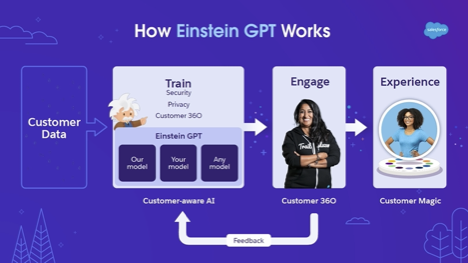When Salesforce announced Einstein GPT – billed as the first generative AI for CRM – at its TrailblazerDX (TDX) conference on March 7th, the claim was true. Just three days later, however, Microsoft announced Microsoft Dynamics 365 Copilot, which uses natural language capabilities powered by Azure OpenAI Service. Then, in a blog published today, Zendesk announced it plans to add ChatGPT integration to expand its AI-powered customer service. Cristina Fonseca, Head of AI, Zendesk, commented, “Our solutions uniquely combine the power of our entire support suite, large language models (LLMs) trained against conversational service tickets and intents and soon the power of OpenAI and ChatGPT.”
It is no exaggeration to say that it is a full-time job keeping up with the ways solution providers are finding to apply the innovations of generative AI to customer experience. Salesforce offered an analyst pre-briefing on their news, and I was able to watch the announcement virtually at the conference, so I will explain their announcement in more detail.
I have heard it said that Einstein GPT is simply a deployment of OpenAI’s ChatGPT – this is not true. Let me highlight what I see as some of the differences.
- Trusted Data Sources: Einstein GPT starts with the trusted customer data companies have been building as a single source of truth in Salesforce since they began using it as a CRM. ChatGPT was trained on information from the Internet including websites, books, news articles, and Wikipedia. ChatGPT does not have real-time access to the Internet. It, therefore, has limited knowledge of the world and events that took place after 2021 (when the broadly available ChatGPT-3 was trained).
- Security: There are multiple security concerns when applying ChatGPT directly in business use cases. For example, ChatGPT may aid cybercriminals, allowing them to impersonate others, write flawless text, and create code that can be misused by anyone with malicious intent. Also, one of the easiest ways to spot a phishing email is to find spelling and grammatical mistakes. An authentic email from your bank is unlikely to be written sloppily, for instance. Hackers could use ChatGPT to write phishing emails that read like they were written by a professional. By contrast, Einstein GPT uses a company’s customer data to train, based on security principles that maintain secure data access to your data, within a Salesforce trust boundary. This protects the privacy of your customers’ personal identifiable information(PII).
- Human oversight: During the announcement of Einstein GPT at TDX, Salesforce was quick to point out that human beings are an important part of the process when using Einstein GPT. As Sarah Franklin, President and CMO, Salesforce, said during the TDX keynote address, “There is a human in the process. This is important because the AI is here to help us, not replace us.” . This, Salesforce believes, will allow companies to “deliver all of the customer magic they want,” said Franklin.
Beyond these core attributes of Einstein GPT, Salesforce demonstrated several ways that the generative AI solution can be incorporated into the various Salesforce applications.
- Sales Cloud: With Einstein GPT, an account executive (AE) can ask for an overview of a new client's business, including . The AE can then ask Einstein GPT to write an introductory email to the client, asking for availability for a meeting and incorporating some of the client's recent news. The entire process, including review and possible revision, takes only a few minutes.
- Slack: Continuing the same example, the AE can ask Einstein GPT to create a private Slack channel between the prospect and the AE.
- Service Cloud: In a customer chat, a customer can ask about a very specific detail of a product and Einstein GPT will quickly generate a response and include the source of the answer. Ensuring there is a human in the loop, the agent can send as is, edit the response or even ask Einstein GPT to create a revised version of the answer – such as making it shorter. Einstein can also deliver a next best action, which the agent can choose to relay to the customer or not, based on the agent's judgment.
- Marketing Cloud: I found this to be the most impressive of the demos. In a matter of a couple of minutes, Einstein ChatGPT can help a marketing manager create a website landing page for an upcoming event, prompt the tool for an appropriate length of text, add a relevant photo, and add a signup form.
NOTE: Some might argue that a few of these activities could be accomplished with Einstein AI before Einstein GPT but I’m OK with the blurring of those lines.
As was true in my post about ChatGPT in the contact center market, it is clear that companies should not be thinking about how to incorporate ChatGPT into their workflows but instead asking their solution providers how they are continuing to innovate by weaving generative AI into their solutions.











